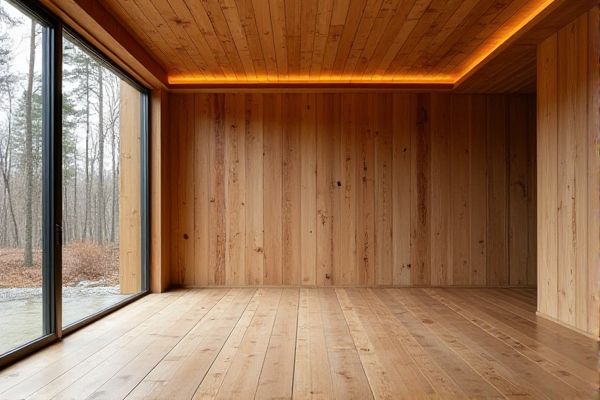
Cedar planks offer a larger surface area ideal for grilling seafood and imparting a smoky flavor, while cedar blocks provide more intense aroma and are better suited for smoking smaller cuts of meat. Discover which cedar option best enhances your cooking technique by exploring the full comparison ahead.
Table of Comparison
| Feature | Cedar Planks | Cedar Blocks |
|---|---|---|
| Material | Thin wooden boards made from cedar | Solid, thick cedar wood blocks |
| Size | Typically 1/4 to 1/2 inch thick, various lengths | Usually 2 to 4 inches thick, smaller footprint |
| Usage | Ideal for grilling fish, vegetables, and delicate items | Suitable for smoking, cooking small portions, or as heat source |
| Flavor Impact | Infuses subtle smoky cedar flavor into food | Provides stronger, deeper cedar smoke flavor |
| Preparation | Soak in water 30-60 minutes before use | May require longer soaking or seasoning for smoking |
| Reusability | Can be reused 2-3 times depending on condition | Generally reusable multiple times if maintained properly |
| Cost | Usually more affordable and widely available | Higher cost due to size and density |
Introduction to Cedar Planks and Cedar Blocks
Cedar planks and cedar blocks are premium grilling accessories made from aromatic Western Red Cedar, prized for infusing food with a rich, smoky flavor. Cedar planks offer a large, flat surface ideal for cooking delicate fish and vegetables evenly, while cedar blocks provide a more versatile, compact option suitable for direct grilling and smoking. Both materials naturally resist moisture and decay, enhancing durability and flavor enhancement during various cooking methods.
Material Composition: Planks vs. Blocks
Cedar planks are typically milled from the heartwood of Western Red Cedar, offering a uniform thickness and smooth surface ideal for even heat distribution and flavor infusion. Cedar blocks, however, are usually cut from denser parts of the cedar tree, providing a more robust wood structure that burns longer and imparts a deeper smoky aroma. Your choice between planks and blocks should consider the specific cooking experience and flavor intensity you desire.
Common Uses and Applications
Cedar planks are primarily used for grilling and smoking foods, providing a distinctive aroma and flavor to seafood, poultry, and vegetables. Cedar blocks are favored for slow cooking and indoor smoking, as they offer controlled, prolonged heat and a subtle infusion of cedar essence. Both enhance culinary experiences but serve different cooking techniques based on size and heat distribution.
Scent Longevity and Effectiveness
Cedar planks offer a longer-lasting and more intense aroma due to their larger surface area and slow, sustained release of natural oils compared to cedar blocks. The thicker material of planks retains the fragrant compounds longer, providing consistent scent diffusion over time. Cedar blocks tend to lose their scent more quickly as their smaller size accelerates oil evaporation, making them less effective for prolonged use.
Installation and Placement Tips
Cedar planks are designed for easy installation, often requiring screws or nails along pre-cut holes, making them ideal for creating an even grilling surface. Cedar blocks, being thicker and chunkier, need stable placement on grill grates or coals to prevent tipping and ensure even heat distribution. Position cedar planks perpendicular to grill grates to avoid flare-ups, while cedar blocks should be spaced with enough airflow for consistent smoking.
Cost Comparison
Cedar planks typically cost more than cedar blocks due to their larger size and finishing process, which involves smoothing and shaping for grilling or smoking. Cedar blocks, being smaller and less processed, offer a more affordable option for flavor infusion in cooking without sacrificing aroma quality. Choosing between the two depends on Your budget and intended use, with planks favored for direct food presentation and blocks ideal for longer, indirect smoking sessions.
Durability and Maintenance
Cedar planks and cedar blocks both offer excellent durability due to natural resistance to moisture, decay, and insects, making them ideal for outdoor use. Cedar planks tend to require more frequent maintenance such as sealing and sanding to prevent warping and splitting, while cedar blocks, being thicker and denser, generally demand less upkeep but may be heavier to handle. Understanding these differences can help you choose the best cedar option for long-lasting performance with minimal maintenance effort.
Environmental Impact
Cedar planks and cedar blocks both derive from renewable timber sources, but the environmental impact varies based on sourcing and processing. Cedar planks often come from larger, milled pieces of wood that may require more energy and resources to produce, whereas cedar blocks are typically smaller cuts with less manufacturing. Choosing sustainably harvested cedar can reduce your carbon footprint and support responsible forestry practices.
Pros and Cons of Cedar Planks
Cedar planks offer excellent heat distribution and a larger cooking surface, enhancing flavor infusion for grilling fish or vegetables, but they require soaking to prevent burning and can be costly compared to cedar blocks. Their flat, thin profile allows for versatile use on grills and smokers, though they can warp or crack if reused multiple times. Cedar planks also impart a milder smoky aroma, making them ideal for delicate foods but less intense than cedar blocks, which may limit their appeal for stronger flavor preferences.
Pros and Cons of Cedar Blocks
Cedar blocks offer improved heat retention and even cooking by providing a stable surface that maintains temperature longer than cedar planks. They are reusable and less prone to burning, making them ideal for grilling meats or vegetables with consistent flavor infusion. However, cedar blocks require more maintenance, such as soaking before use and thorough cleaning, and their thicker size may limit flexibility in presentation and cooking techniques.
 homyna.com
homyna.com